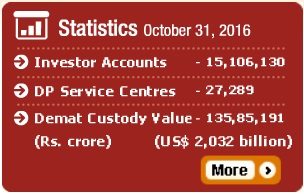Dematerialization | Meaning | Process | Procedure of Purchase & Sale
Table of Contents
What is Dematerialization? How is Dematerialization done?
Dematerialization is the process by which physical share certificates of an investor are taken back by the company/registrar and destroyed. Then an equivalent number of securities in the electronic form are credited to the investors account with his Depository Participant.

Dematerialization is done at the request of the investor. Investors will first have to open an account with a DP (Depository Participant) and then request for dematerialization of certificates through the DP.
Purchases made by an investor are credited to his account and sales are debited. The securities held in dematerialized form are fungible. In other words they do not have any distinguishing features. Dematerialized shares do not have any distinctive numbers. All the holdings of a particular security will be identical and interchangeable.
Trading in dematerialized shares commenced on the NSE in December 1996 where Reliance Industries was the first company to trade its 100 shares in demat form. In case of the BSE, dematerialization of shares commenced in the year December 1997.
Process of dematerialization
The following are the steps involved in the process of dematerialization:
1. The investor is required to fill up the Demat Request Form (DRF) available with the DP and submit it along with the physical certificates which need to be dematerialized. Odd lot shares can also be dematerialized.
2. Depository participant (DP) intimates the Depository of the request from his approved user hardware system.
3. Depository participant submits the certificates to the Registrar.
4. Registrar confirms the dematerialization request from depository.
5. After dematerializing certificates, Registrar updates the accounts and informs depository of the completion of dematerialization.
6. Depository updates its accounts and informs the depository participant.
7. Depository participant updates the account and informs the investor.
Number of active demat accounts with NSDL
The following table shows the number of active dematerializiation accounts with National Securities Depository Limited (NSDL) over a period of 15 years.
| Year | No. of DEMAT Accounts with NSDL (in lakhs) |
|---|---|
| March 2002 | 37 |
| March 2003 | 38 |
| March 2004 | 52 |
| July 2005 | 65 |
| July 2006 | 77 |
| July 2007 | 78 |
| March 2008 | 93 |
| July 2009 | 99 |
| July 2010 | 107 |
| July 2011 | 117 |
| July 2012 | 122 |
| July 2013 | 128 |
| July 2014 | 132 |
| July 2015 | 139 |
| Oct 31 2016 | 15,106,130 |
Source: NSDL

An investor can dematerialize all his investment in securities such as shares, debentures, mutual fund units, government securities etc and hold them in a single demat account.
Procedure for purchase of dematerialized securities
The transactions relating to purchase of securities are:
1. The investor purchases securities through a broker.
2. He pays the broker who then arranges payment to the clearing corporation on the pay-in day.
3. The broker receives credit of securities in his clearing account (clearing member pool account) on the pay-out day.
4. Broker gives instructions to its DP to debit clearing account and credits the investor’s account.
5. The investor receives shares into his account. If standing instructions are not given at the time of opening the account, the investor has to give ‘Receipt Instructions‘ to the DP for receiving credit.
6. The investor has to ensure that the broker transfers the securities from his clearing account to the investor’s depository account before book closure. If the securities remain in the clearing account of the broker. the company would give corporate benefits (dividend or bonus) to the broker. In that case, the investor will have to collect the corporate benefits from the broker.
Procedure for sale of dematerialized securities
1. The investor sells the securities in any of the stock exchanges linked to the National Securities Depository Limited (NSDL) through a broker.
2. He has to instruct his Depository Participant (DP) to debit his account with the number of securities sold and credit broker’s clearing account.
3. The delivery instruction has to be given by the investor to his DP using the delivery instruction slips, received by him at the time of opening the demat account from the DP.
4. Before the pay-in day, the investors’ broker gives instructions to its DP for delivery to clearing corporation.
5. The investor receives payment from the broker for the sale of securities.


Very good this blog help me a lot to understand what is dematerialisation and process of it ,thanku soo much for providing such a wonderful content